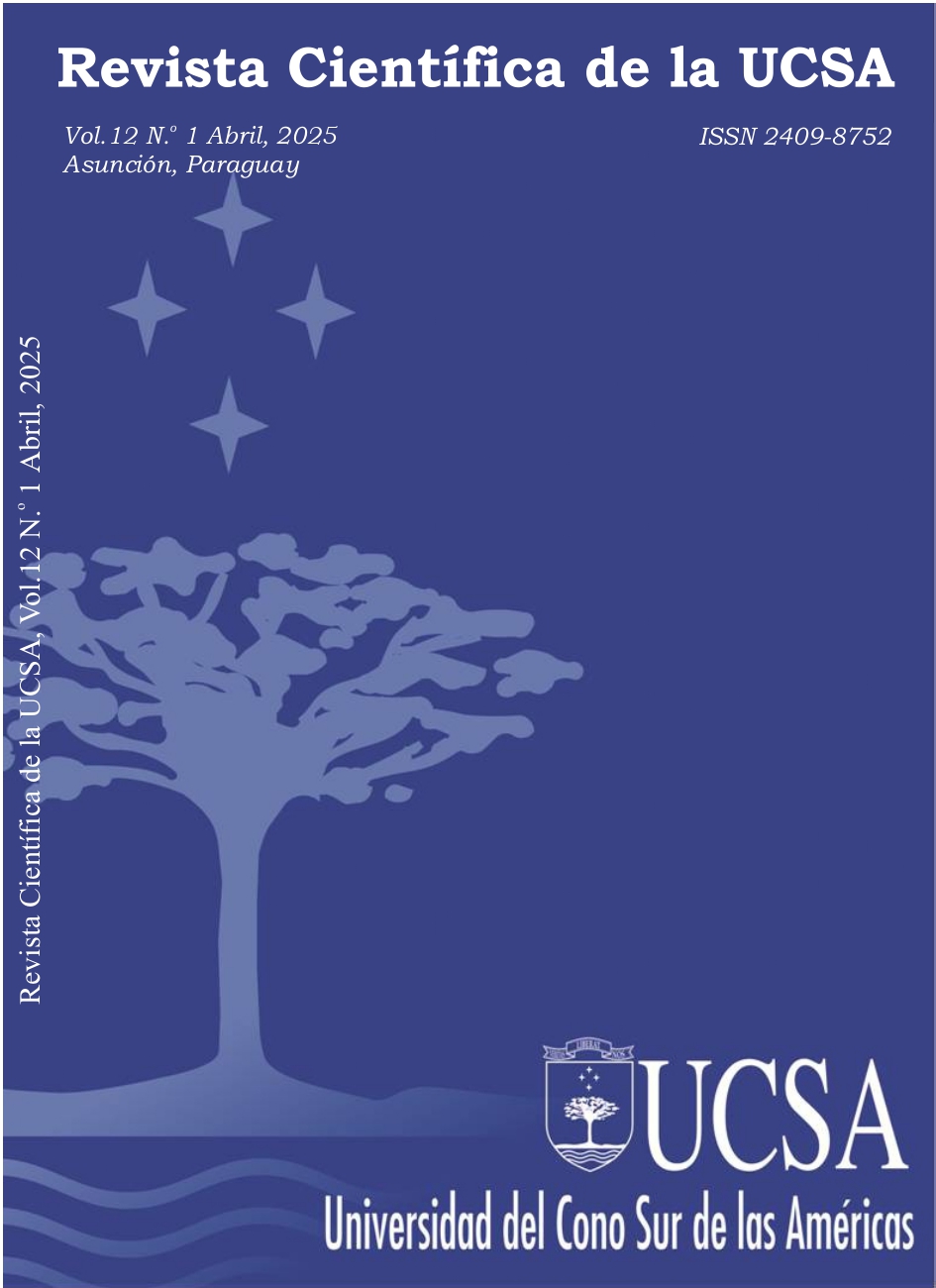Perception of Feng Shui in university academics from Paraguay
Main Article Content
Abstract
The general objective is to determine the degree of knowledge and perception of Feng Shui in the Paraguayan educational community. It was based on a quantitative, non-experimental, transactional and descriptive approach. A total of 433 academic collaborators from a private university in Paraguay was formed as the population with a sample of 157 participants. The response rate was 84% (132 participants), but only 58% (76) of the responses were analyzed, due to their knowledge of the subject. The inclusion criteria were academics from the university analyzed, active and with voluntary participation. The survey was conducted using a questionnaire composed of 3 dimensions (Beliefs and Implementation of Feng Shui [D1], Importance of Feng Shui [D2] and Perceived Impact of Feng Shui [D3]), 3 indicators and 11 items (Knowledge and Application [CA-4], Work Context [CL-3] and Perception of Benefits [PB-4]) for convenience in 2024. The results indicate that the means of the three dimensions are fairly balanced: Beliefs and Implementation of Feng Shui (x̄=2.9), Importance of Feng Shui (x̄=2.7) and Perceived Impact of Feng Shui (x̄=2.2) and the items related to Feng Shui in the PB indicator scored high (x̄=3.7), while the CL3 item received the lowest score (x̄=2.5). It is concluded that Feng Shui is known by the respondents, but its work application generates skepticism. However, a positive impact on organizational climate and efficiency is perceived. Its adoption requires greater awareness to promote its acceptance in the business environment.
Article Details
Section
How to Cite
References
Aldaz Quinto, A. del R., Alvarado Torres, W. Y., Castro Ramírez, N. A., & Fajardo Campaña, C. M. (2022). Clima organizacional y desempeño laboral. Ciencia Latina Revista Científica Multidisciplinar, 6(1), 1382-1393. https://doi.org/10.37811/cl_rcm.v6i1.1588
Antonietti, L., Ortiz, Z., Esandi, M., Duré, I., & Cho, M. (2020). Condiciones y medio ambiente de trabajo en salud: Modelo conceptual para áreas remotas y rurales. Revista Panamericana de Salud Pública, 44, 1. https://doi.org/10.26633/rpsp.2020.111
Balabani, M. (2019). Diseño de parques y jardines: Experiencias en el AUL. Reflexión Académica - Universidad de Palermo.
https://dspace.palermo.edu/ojs/index.php/rad/article/view/6124
Bevilacqua, F. (2021). Diseño de interiores: Equipamiento y mobiliario. CP67.
Burbano, A., & Páramo, P. (2020). El tercer maestro: La dimensión espacial del ambiente educativo y su influencia sobre el aprendizaje. Universidad Pedagógica Nacional. http://repositorio.pedagogica.edu.co/bitstream/handle/20.500.12209/12721/Repositorio_El%20tercer%20maestro.pdf?sequence=1&isAllowed=y
Ching Chiy, J. Y., Benites Mora, L. de las M., & Salgado Granda, B. A. (2024). Optimización del uso de la caña gradúa en el diseño de interiores funcionales y decorativos para la comuna Libertador Bolívar. Revista Social Fronteriza, 4(6), e46515. https://doi.org/10.59814/resofro.2024.4(6)515
Ching, F. D., & Binggeli, C. (2023). Diseño de interiores: Un manual. Editorial GG.
Cota Luevano, J. A. (2017). Método para evaluar el clima organizacional del área docente de un centro de bachillerato tecnológico de CD. Obregón, Sonora. Revista Ciencias Administrativas FCE, (10), 39-45. https://doi.org/10.24215/23143738e010
Diccionario de la Lengua Española (s.f.). Feng Shui. https://dle.rae.es/feng%20shui
Harari, E. (2021). Nuevo Feng Shui: Una propuesta contemporánea. Trópico de Escorpio.
Ho, S. H., & Chuang, S.-T. (2012). The influence of lay theories of Feng Shui on consumers’ peace of mind: The role of regulatory fit. Asian Journal of Social Psychology, 15, 304-313. https://doi.org/10.1111/j.1467-839X.2012.01385.x
Imperial Harvest. (2023). Entendiendo el Bagua (八卦). https://imperialharvest.com/blog/understanding-bagua/
Koppel, M. (2012). Feng Shui en el trabajo y los negocios. ALAMAH.
Kwan Chung, C. K., & González Caballero, J. A. (2023). Diagnóstico ergonómico en colaboradores de una universidad privada de Paraguay, 2022. Ciencia Latina Revista Científica Multidisciplinar, 7(1), 606-620. https://doi.org/10.37811/cl_rcm.v7i1.4416
Chap Kau K.C., Sosa Viera M.J., & Velázquez Borel C.A. (2024a). Diagnóstico del clima organizacional en colaboradores de una empresa de servicios en Paraguay, 2023. Revista UNIDA Científica, 8(1), 1–7. https://doi.org/10.69940/ruc.20240601
Kwan Chung, C. K., Céspedes Miranda, V. E., Arce Benítez, V. C., & Cabrera Rotela, A. E. (2024b). Diagnóstico del clima organizacional en colaboradores de una empresa del rubro alimenticio en Paraguay, 2022. Revista UNIDA Científica, 8(1), 24–30. https://doi.org/10.69940/ruc.20240605
Kryžanowski, Š. (2021). Impact of Feng Shui bedrooms on self-assessed sleep and well-being: A randomized double-blind field research with instrumental biocommunication. South East European Journal of Architecture and Design, 2021, 1-8. https://doi.org/10.3889/seejad.2021.10057
Merriam Webster (s.f.). Feng Shui. https://www.merriam-webster.com/dictionary/feng%20shui
Nationsonline.org (s.f.). Bagua. https://www.nationsonline.org/oneworld/Chinese_Customs/bagua.htm
National Geographic. (2022). Qué significa el Yin Yang. https://www.nationalgeographicla.com/historia/2022/12/que-significa-el-yin-yang
Ochoa, A. (2021). ¿Qué es el Feng Shui y cómo aplicarlo en la decoración del hogar?. https://www.admagazine.com/interiorismo/feng-shui-que-es-y-como-aplicarlo-en-la-decoracion-del-hogar-20210119-8007-articulos
Olivera-Garay, Y. J., Leyva-Cubillas, L. L., & Napán-Yactayo, A. C. (2021). Organizational climate and its influence on the work performance of workers. Revista Científica de la UCSA, 8(2), 3-12. https://doi.org/10.18004/ucsa/2409-8752/2021.008.02.003
Pixabay (s.f.). Bagua. https://pixabay.com/vectors/bagua-yin-yang-yang-yin-chinese-1601156/
Porro, S., & Quiroga, I. (2021). El espacio en el diseño de interiores. CP67. Nobuko. Ríos-López, L. A., Saldaña-Pinto, C. A., Alejandría-Castro, C. A., & Fasanando-Puyo, T. (2023). Factores relacionados con el clima organizacional. Revista Amazónica de Ciencias Económicas, 2(1), e455. https://doi.org/10.51252/race.v2i1.455
Samson, J., (s.f.). Feng Shui: El viento y el agua. https://academic.mu.edu/meissnerd/samson.html
Torres Arroyo, J. G. (2021). El diseño del paisaje en la formación del diseñador de interiores. Reflexión Académica, 1, 74-75.
https://dspace.palermo.edu/ojs/index.php/rad/article/view/4680
Villalba, L. M. (2021). Diagnóstico del clima organizacional en colaboradores de una empresa financiera en Asunción - Paraguay. Revista científica en Ciencias Sociales, 3(1), 8–15. https://doi.org/10.53732/rccsociales/03.01.2021.8

